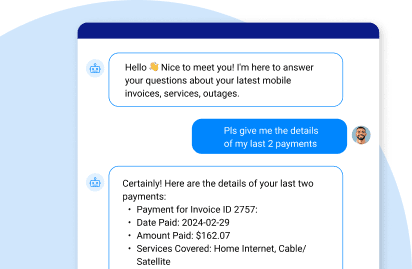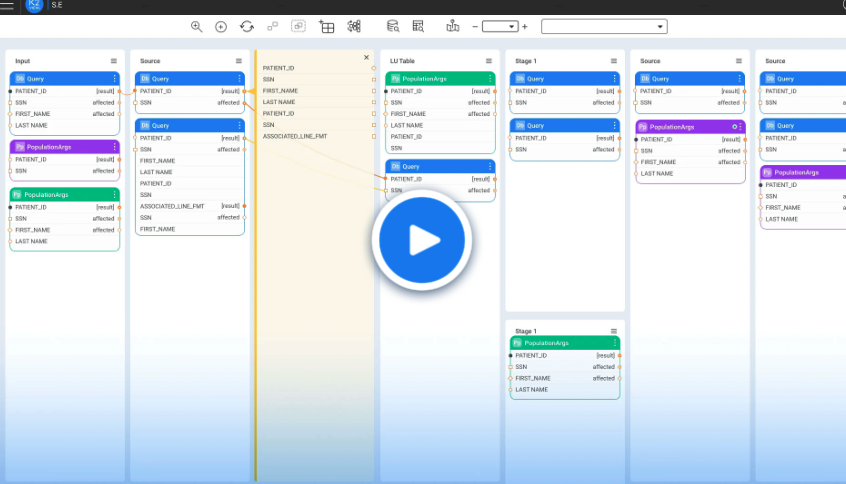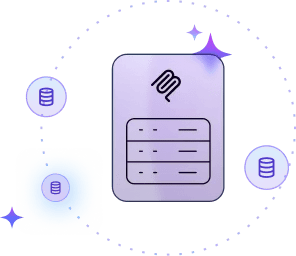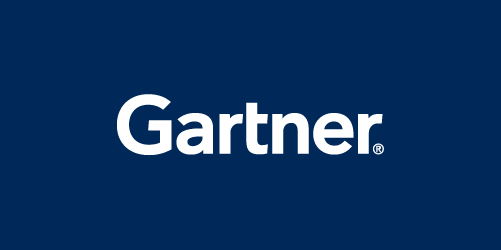A practical guide to implementing model context protocol for AI
What is MCP AI?
Last updated on September 3, 2025

See Agentic AI in Action
Go behind the scenes and see how we ground AI agents with enterprise data

Start your live product tour
 Table of Contents
Table of Contents
Model Context Protocol for AI (MCP AI) is an open standard that contextualizes LLM queries by letting AI agents call external tools and live data sources.
01
What is MCP AI?
MCP AI (Model Context Protocol for AI) is an open-source protocol developed by Anthropic and released in November of 2024. It represents a significant step forward in enabling easy integration between Large Language Models (LLMs) and a broad range of data sources – addressing the critical need for widespread data access within the realm of generative AI (GenAI).
A protocol defines the rules governing data formatting and processing. MCP LLM establishes a standardized set of rules for how LLMs connect with different external data sources. Such standardization overcomes some of the complexities involved with integrating GenAI with existing enterprise ecosystems.
A recognized standard like MCP AI eliminates the need for customized connectors for every data source. Maintaining context is crucial to generating accurate and relevant LLM responses, so MCP's unified approach to data access is essential for unlocking the full potential of GenAI for the enterprise.1
Anthropic describes model context protocol as “an open protocol that standardizes how applications provide context to LLMs. Think of MCP like a USB-C port for AI applications. Just as USB-C provides a standardized way to connect your devices to various peripherals and accessories, MCP provides a standardized way to connect AI models to different data sources and tools.”2
02
MCP AI architecture
MCP AI architecture was specifically designed to enable standardized communication between LLMs and a diverse range of integrations. This section outlines the fundamental components allowing MCP AI to unify data access for generative AI workflows.3

MCP AI uses a client-server model for communication
Overview
MCP AI uses a client-server model, in which:
- The MCP client (running inside the host LLM app) opens a direct connection to one or more servers.
- Each MCP server advertises its tools, context, and optional prompt snippets. The server invokes the right tools to satisfy the client request (e.g., pull data via APIs or database queries), and routes the response back to the client.
For example, a customer service chatbot might initiate the following request from an MCP server for a particular customer's information. It doesn't need to know how the data is retrieved or where it is retrieved from.
Client request:
{
"model_id": "chatbot-llm-001",
"entity_type": "customer",
"entity_id": "CUST-39201",
"use_case": "support_summary",
"context_fields": ["recent_interactions", "open_tickets", "account_status"]
}
The MCP server selects and orchestrates the correct tools to satisfy the request, assembling the response back to the MCP client:
MCP server response:
{
"entity_type": "customer",
"entity_id": "CUST-39201",
"context": {
"full_name": "Dana Moore",
"account_status": "Active",
"recent_interactions": [
{
"date": "2025-07-01",
"channel": "chat",
"summary": "Customer asked about service outage."
},
{
"date": "2025-07-03",
"channel": "email",
"summary": "Requested refund for overcharge."
}
],
"open_tickets": [
{
"ticket_id": "TCK-11224",
"status": "Pending",
"issue": "Billing discrepancy"
}
]
},
"metadata": {
"retrieved_at": "2025-07-07T14:45:22Z",
"data_quality_score": 0.98
}
}
Core components
Protocol layer
The protocol layer handles message framing, request/response linking, and high-level communication patterns.
Transport layer
The transport layer handles the actual communication between clients and servers. MCP LLM supports multiple transport mechanisms, including Stdio transport for local processes and HTTP with Server-Sent Events (SSE) for server-to-client messages and POST for client-to-server messages.
Message types
MCP supports the following message types:
- Requests expect a response from the other side.
- Results are successful responses to requests.
- Errors indicate that a request failed.
- Notifications are one-way, no-reply messages.
Connection lifecycle
- Initialization
This step establishes the session between the MCP client and server, including authentication, version negotiation, and context setup. It ensures both sides are aligned on protocol rules and ready for message exchange under a shared understanding. - Message exchange
Structured messages are exchanged according to the agreed-upon context. This includes request/response interactions, data transfers, or operational commands, all following strict validation and sequencing rules defined by the protocol. - Termination
Termination cleanly closes the session once communication is complete. - Error handling
This step ensures the system can detect, report, and respond to issues that arise during communication. This includes problems like invalid messages, timeouts, or incompatible versions.
At a high level, MCP AI is an open protocol that provides a discoverable, composable, and open interface used by GenAI applications to interact with data and tools.
03
Why enterprises are adopting MCP AI
Until MCP AI came along, connecting LLMs to external data had dev teams creating separate integrations for every API and database – each with different authorizations, data formats, and error handling. By standardizing these interactions MCP AI delivers4:
Quick integrations
With MCP for LLMs, you can plug-‘n-play new capabilities without having to custom-code each from scratch. If there’s an MCP server for a database, then any MCP-compatible LLM can connect to it. The protocol enables LLM function calling for retrieving data, querying databases, or recruiting APIs, as needed, just by adding the right server. Imagine a library of pre-made plugins that make specific capabilities available through one standardized protocol.
Autonomous agents
MCP AI lets LLM-powered autonomous agents make decisions and perform tasks without human intervention. Autonomous agents use MCP AI to enhance LLM capabilities by integrating with various tools, accessing APIs, retrieving information, and managing workflows in real time. And with memory and reasoning components, they can suggest strategies, learn from past interactions, and continuously improve performance. MCP helps autonomous agents develop not only the thinking – but also the action-taking – of GenAI by giving it standardized access to all relevant data.
Easy setup
Because MCP AI is a universal interface, developers no longer need to maintain separate integrations. Once an application supports MCP, it can connect to any number of services through a single mechanism – reducing the manual setups required each time you want your LLM to use a new API. Dev teams can focus on higher-level logic rather than rewriting connection code for the umteenth time.
Universal language
MCP AI standardizes a universal request-response language across tools so your LLM needn’t cope with one response for one service, and another response for another. All function calls and tool results are communicated in a uniform structure, for simpler debugging and scaling. MCP AI also ensures your integration logic is future-ready – even if you switch vendors, MCP’s interface to the tools remains the same.
Conversational context
MCP AI maintains context in the never-ending conversation between LLMs and GenAI apps. An MCP server can provide pre-built prompt templates for certain tasks, and plain old data context for others. It allows your LLM to ingest reference data, or follow complicated workflows, without relying solely on APIs. Built to support rich interactions, MCP AI is especially useful for coding or complex decision making that may require multiple interactions with different data sources.
MCP AI also provides an easily scalable approach to enhancing LLMs, giving them access to the fresh, trusted data they crave while allowing AI agents to tap into knowledge bases, DevOps tools, and enterprise systems.
RE MCP, Gartner predicts that 75% of gateway vendors and 10% of iPaaS providers will have model context protocol features by 2026.
04
MCP AI use cases
MCP AI can be applied to a broad range of use cases, notably:
Real-time grounding for financial risk
Financial institutions operate in real time to detect fraud, assess risk, and verify identities. With MCP AI, LLMs can access fresh enterprise data to satisfy both customers and compliance laws. They can retrieve transaction, fraud, and customer data from any system for enhanced contextual understanding.
Personalized healthcare and patient journeys
Healthcare providers use GenAI to interact with patients on basic tasks like scheduling appointments or sending reminders to update Rx prescriptions. MCP AI allows secure, compliant streaming of patient histories straight into LLM-powered patient engagement tools while constantly protecting privacy.
AI chatbots and assistants for retail and telecom
In sectors like retail and telecom, delivering personalized experiences depends on understanding customer context the moment it’s needed. An MPC server provides this context to conversational AI chatbots or AI virtual assistants by reviewing order data, interactions, preferences, and service status from multiple underlying systems in real time.
Conversational AI and agentic AI workflows
MCP AI enables conversational AI and agentic AI workflows to handle complex business operations. For example, LLM-powered autonomous agents may need to issue support tickets, check regulatory rules, or review delivery schedules across many systems. MCP empowers AI agents to decide and act in the right context.
Compliance, governance, and service automation
In highly regulated industries, all AI-generated answers – and the data that informs them – must be auditable. With MCP AI, every LLM response can be easily traced back to its data sources. With a single governance layer, enterprises can automate compliance checks, service requests, and reporting.
Adoption patterns in the real world
Businesses adopting MCP AI typically start by piloting a single high-value use case, then moving it into production as trust and value are proven. With MCP LLM models can be enriched with context in minutes for fast time to innovation.
05
MCP AI best practices
To get the most from an MCP AI implementation, organizations should follow a few key best practices that ensure accurate, secure, and high-performance access to business data for LLM-powered applications.
Centralize the MCP server architecture
Rather than deploying an MCP instance for each enterprise system, organizations should adopt a single, unified MCP server that connects to multiple backend systems. A centralized MCP server simplifies integration, reduces operational overhead, and enables consistent context management across use cases. It further acts as the shared brain of enterprise AI, dynamically composing context from distributed systems without duplicating logic or infrastructure.
Enforce entity-based data guardrails
AI interactions should be scoped to individual business entities – such as a customer, product, or order – at runtime. Entity-level guardrails restrict LLM access to relevant data only, reducing the risk of exposure, respecting data privacy, and ensuring more focused and accurate responses.
Prioritize conversational latency
MCP AI implementations must be optimized for real-time, conversational AI performance. Since the protocol sits on the critical path between user queries and LLM responses, low-latency retrieval of contextual data is essential. Leveraging high-speed data access patterns and memory-resident architectures can significantly reduce response times and improve user experience.
Build a rich semantic layer
A well-designed MCP for LLMs should expose a semantic layer that accurately describes each data attribute with business-friendly metadata. This includes data types, relationships, source lineage, and contextual meaning – all of which guide the LLM in forming precise, relevant answers. A rich semantic layer not only improves AI quality but also makes the system more transparent and maintainable.
By following these practices, organizations can ensure their MCP AI implementation serves as a robust and scalable foundation for AI experiences that are fast, secure, and contextually aware.
06
Risks of model context protocol for AI
While the benefits of MCP AI can be significant, it also has its security risks5:
Stolen tokens and compromised accounts
MCP storage of Open Authorization (OAuth) tokens is a critical vulnerability. For example, if unauthorized users get access to your Gmail token, they’d be able to:
- Access your entire email history
- Send, forward, and delete messages from your account
- Identify and use your Personally Identifiable Information (PII)
Compromised MCP servers
MCP servers represent a particularly attractive target for malicious actors due to their role in centralizing OAuth tokens for many different services. Attackers could:
- Get all your tokens, including those for Gmail, Google Drive, Calendar, and more.
- Take unauthorized actions, across all these interconnected platforms.
- Expose corporate resources, if you linked your work accounts through the MCP server.
- Persist even after you change your password, because OAuth tokens often maintain their validity independently.
Indirect prompt injection threats
MCP for AI introduces a new threat through indirect prompt injection. Since the AI assistant interprets natural language commands before sending them on to the MCP server, attackers could craft seemingly benign messages containing concealed malicious instructions.
For instance, an email that appears harmless could contain embedded text that, when processed by the GenAI app, instructs it to forward all financial documents to an external address. This subtle threat is particularly dangerous, as users may be unaware that sharing certain content with their AI could lead to automated and harmful actions being performed through MCP, blurring traditional security boundaries between content viewing and action execution.
Lax and aggregated permissions
To provide the broadest possible functionality, MCP servers often request extensive permissions, introducing significant privacy and security concerns, such as the following:
- MCP servers may be granted unnecessarily wide-ranging access to connected services (e.g., full access to your email account instead of more restrictive read-only permissions).
- Centralized storage of authentication tokens might lead to data aggregation in the MCP server.
- Malicious actors who manage to gain access to the server could conduct correlation attacks across interconnected services. For example, with access to both your calendar and email accounts, attackers could mastermind highly targeted phishing or extortion campaigns.
- Legitimate server operators could, in theory, mine aggregated user data across services for commercial gain or to build detailed user profiles.
Additionally, while most apps were originally designed to provide segregated access to user data, the concentration of access to different services within a single protocol may seriously alter established LLM guardrails.
07
MCP AI challenges in multi-source environments
In addition to the security and privacy risks cited above, MCP AI faces other challenges, including:
Fresh real-time data
Stale data can result in inaccurate suggestions or missed opportunities. A primary challenge for an MCP server is accessing fresh data from the SAP landscape and connected systems. To function effectively, MCP clients require rapid, real-time access to the latest information. Because conversational interactions demand speed, MCP servers must efficiently fetch and process data from multiple sources to ensure timely and relevant responses. Here's a list of the most awesome MCP servers for 2025.
Data integration at the speed of AI
Retrieving information for AI agents about customers, suppliers, employees, or other business entities entails integrating data from multiple systems like SAP, Salesforce, Workday, and support platforms. Each of these systems would require its own MCP server, delegating cross-system data harmonization to the AI agent. This implies that agentic AI systems must be supported by:
- Metadata enrichment and semantic layers
- Entity resolution (master data management)
- Tooling descriptions and ontology mappings
- Aggregator layers that unify responses
- Few-shot models (chain-of-thought reasoning)
Precise responses
Without current and unified data access, LLMs may generate plausible but incorrect information based on incomplete or outdated data.
To address these challenges, generative AI techniques such as chain-of-thought prompting (guiding the model step by step), retrieval-augmented generation (retrieving data at runtime), and table-augmented generation (querying and interpreting tabular business data) need to be implemented.
Additionally, metadata enrichment and management (data cataloging), data governance (data quality and privacy enforcement), and real-time data integration are required.
Solving these data access hurdles is crucial for organizations aiming to leverage the full capabilities of AI agents, grounded in accurate and secure business information.
These challenges were highlighted in a recent K2view survey, where fragmented, hard-to-access data was identified as a significant obstacle by most respondents.
08
RAG vs MCP AI
The model context protocol for AI is not the first attempt at standardizing context injection to LLMs. Other frameworks, like Retrieval-Augmented Generation (RAG), also ground LLMs with internal data. What’s the difference between these two approaches?
While both RAG and MCP AI deliver context to GenAI apps, they can be seen as complementary or potentially overlapping approaches to enhancing the accuracy and security of LLM responses within the context of enterprise data. Let’s take a closer look at their relationship.
| Attribute | Retrieval-Augmented Generation (RAG) | Model Context Protocol for AI (MCP AI) |
| Objective | To ground LLMs on enterprise data | To connect GenAI apps to external data |
| Procedure | Retrieves relevant data at query time | Defines a protocol based on a client-server model |
| Focus | Provides LLMs with the context to answer accurately | Accesses and interacts with data in a governed manner |
| Data access | Fetches data based on the semantic similarity of a query | Controls data movement between client and server |
| Context injection | Injects context into the prompt | Injects context via the data retrieved from the MCP servers |
| Hallucination prevention | Delivers specific trusted data | Ensures that data is drawn from authorized sources |
| Real-time data | Works with real-time data sources | Streams enterprise data in real time |
| Security and governance | Adds security to data retrieval | Has MCP guardrails built in |
| Use cases | Customer service chatbots and AI virtual assistants | Agentic AI models that are trained to decide and act |
In theory, RAG could be implemented in an MCP infrastructure. A GenAI app (MCP client) could use the protocol to query an MCP server for relevant data. The MCP server, in turn, could orchestrate data retrieval from various sources, potentially including enterprise systems and knowledge bases used for RAG-style retrieval. The retrieved information could then be used as context for the LLM's generation.
MCP AI and RAG are not mutually exclusive. MCP can provide the secure and governed data access layer that RAG can then leverage to retrieve specific context for its generation process. MCP offers a broader framework for AI-data interaction, while RAG is a specific technique focused on improving the quality of generated text based on retrieved information.
09
Optimizing MCP AI with data products
K2view acts as a universal MCP server for any enterprise through its data product approach. Instead of building a unique integration for each LLM or AI project, every data product, whether sourced from the cloud or from legacy systems, is discoverable and served through the MCP protocol – bringing true business context and scale to your GenAI apps.
K2view MCP data integration delivers:
- Unification of fragmented data
Data is aggregated from all sources and exposed at conversational latency for immediate use. - Granular privacy controls
PII and other sensitive is always protected, because only authorized users and use cases can access it. - Real-time data delivery to AI agents and LLMS
Data is delivered via built-in data virtualization and transformation capabilities for consistency and context. - Support for on-prem and cloud environments
Enterprises can deploy their GenAI tools anywhere they want. - Complete auditability
Each context package can be traced, and every access is logged for compliance.
These features are essential for regulated industries, and for any business where accuracy and trustworthiness are required.
Survey data from our Enterprise Data Readiness for GenAI in 2024 report shows only 2% of businesses are currently ready for GenAI at scale, the biggest barriers being the inability to access fragmented data, poor lineage, and privacy gaps.
With MCP AI, the K2view platform overcomes these challenges.
10
K2view makes MCP AI enterprise-ready
Instead of running separate MCP servers for every source system, K2view unifies data from Salesforce, SAP, SQL server, and all other enterprise systems into a single governed data product – exposed through one MCP server.

With K2view, one client connects to one server for all data sources.
This means AI agents and LLMs gain secure, real-time access to harmonized data across silos, eliminating fragmentation and stale context.
With its patented semantic data layer, K2view accesses both structured and unstructured data, applies granular privacy controls, and delivers answers at conversational latency – for AI that is accurate, compliant, and always up to date.
By grounding GenAI in trusted enterprise data, K2view helps organizations unlock advanced MCP AI use cases and scale confidently across the business.
Model Context Protocol FAQ
What is the use of model context protocol (MCP)?
MCP is designed primarily for developers building custom integrations and AI applications. MCP enterprise deployments are ideal for teams with technical resources that need to build specialized AI capabilities into their own applications or workflows.7
What is an LLM MCP?
The Model Context Protocol (MCP) is set to be the standard for connecting LLM applications to external data sources and tools. Introduced by Anthropic in November, it has since gained broad backing, including from OpenAI, Microsoft, and Google.8
What is MCP in AI agents?
Model Context Protocol (MCP) is an open standard developed by Anthropic, the company behind Claude. While it may sound technical, but the core idea is simple: give AI agents a consistent way to connect with tools, services, and data — no matter where they live or how they're built.9
Is Model Context Protocol free?
The Model Context Protocol is an open-source project run by Anthropic, PBC. and open to contributions from the entire community.10
What are MCP tools?
MCP tools allow servers (an MCP SQL server, for example) to expose executable functions that can be invoked by clients and used by LLMs to perform actions. Key aspects of tools include:11
Why do we need MCP?
MCP is a fundamental shift that could reshape how we build software and use AI. For AI agents, MCP is transformative because it dramatically expands their reach while simplifying their design. Instead of hardcoding capabilities, an AI agent can now dynamically discover and use new tools via MCP.12
Why do we use MCP?
MCP servers can expose various tools and resources to AI models, enabling functionalities such as querying databases, initiating Docker containers, or interacting with messaging platforms like Slack or Discord.13
What is the MCP protocol?
The Model Context Protocol (MCP) is an open standard introduced by Anthropic with the goal to standardize how AI applications (chatbots, IDE assistants, or custom agents) connect with external tools, data sources, and systems.14
What problem does MCP solve?
Every new data source requires its own custom implementation, making truly connected systems difficult to scale. MCP addresses this challenge by providing a universal, open standard for connecting AI systems with data sources, replacing fragmented integrations with a single protocol.15
















-1.png?width=501&height=273&name=GenAI%20survey%20news%20thumbnail%20(1)-1.png)

